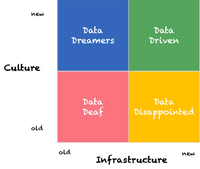Data Culture: the undervalued dimension
September 2023
by Michiel Croon
In the evolving landscape of data-driven organizations, it's clear that data production is only half the story. While most discussions focuses on the collection and analysis of data, the often-neglected dimension of data adoption holds the key to unlocking its true potential. In this article, we explore the critical interplay between data production and adoption, shedding light on why understanding adoption is an indispensable facet of nurturing a data driven culture.
Becoming a truly data-driven company is a multifaceted journey that requires both investment in data production and data adoption. These two dimensions, while interconnected, have distinct roles in transforming an organization into a data-driven powerhouse.
Data Production: Managing the Fuel
Data production encompasses data management, analysis, and visualization. It's the process of collecting, storing, processing, and presenting data. This is where most companies typically spend most of their time and effort. This is the process of creating valuable insights, with dashboards, reports and ad-hoc insights available for managers. For this, companies need to build the right infrastructure: processes, tooling, knowledge and skills need to be in place.
In a data-driven company, effective data production is essential because it provides the raw material for data-driven decision-making. This proces consists of:
- Data Management: Efficient data management ensures data is accurate, accessible, and secure. It forms the foundation upon which data-driven insights are built.
- Data Analysis: Data analysis extracts meaning from data, revealing patterns, trends, and actionable insights. It empowers organizations to make informed decisions.
- Data Visualization: Data visualization transforms complex data into comprehensible visual representations. It enhances communication and helps stakeholders understand data-driven findings.
Data Adoption: Transforming Behavior
Data adoption, on the other hand, is about fostering a data-centric mindset and culture within an organization. A culture can be defined as all the habits, rules, attitudes and behaviors within an organization. The right data culture supports behaviors like fact-based decision-making, experimentation and continuous learning.
Looking at these behaviors in a bit more detail:
- Fact-Based Decision-Making: In a data-driven company, decisions are rooted in data-driven insights rather than intuition alone. This approach requires a commitment to using data to guide choices at all levels. Fact based decision making is a process with clear defined steps to which employees in a data driven organization are committed. In a next article we will do a further deep-dive on this topic.
- Experimentation: Embracing experimentation means taking calculated risks and learning from failures. It encourages innovation and helps organizations adapt quickly to changing circumstances. Experimentation is
- Continuous learning: curiosity is the driving force behind exploration and discovery. Curious individuals are more likely to dig into data, ask probing questions, and uncover hidden insights. Also, managers should challenge themselves on every decision: did I base my decision on data? If not, what data can help me to do so?
Balancing data production and adoption is essential because one without the other leads to an incomplete data-driven transformation. Data production provides the fuel, while data adoption ensures the engine (people and processes) effectively utilizes that fuel. To our opinion, organizations need to develop both dimensions simultaneously; working on adoption of data after building your insights capability often leads to disappointment.
Data adoption versus data production
Looking more closely on infrastructure and culture we can roughly make a difference between 'old' versus 'new:
For culture we also have a high-level understanding for old versus new:
The matrix below shows how organizations can be characterized depending on how they perform on these two dimensions.
- Data Deaf: basically companies that have not started their data journey or those that are don't see the value in it
- Data dreamers: companies prioritizing data adoption without robust data production, in most cases leading to misguided decision-making
- Data disappointed: this is where a lot of companies see their ambitions being data driven come to a stop. Despite having a lot of insights, people still make decsions based on opinions or status within the company. There is no common shared value regarding data and people are mostly not aware of the advantages data can bring to them.
- Data driven: companies that understand you need to develop both dimensions. Research shows less than 25% of the companies consider themselves data driven. You will find digital native companies (Bol. com, Amazon, Coolblue) in this segment. These companies working with data in their DNA and they understand the value and principle of working with both data dimensions.
Matrix: data infrastructure vs data culture (Copyright BrainMovers-2023)
Coming articles will be deep diving on how you can build the right data driven culture in your organization. For this, we have developed a change framework especially aiming at realizing a data driven organization, looking both at infrastructure and culture needed.
Interested in what BrainMovers can do for your organization? Feel free to contact us and let's start a data conversation.


